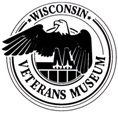|
|
Summary Information
Edward S. DeNomie Papers and Photographs
1910-2008
WVM Mss 1227
0.2 linear ft. (1 archives box) of papers, 0.6 linear ft. (1 archives box, one flat box, and 61 negative flaps) of photographs.
Wisconsin Veterans Museum (Map)
Manuscripts and photographs relating to the service of Edward DeNomie, a Bad River Ojibwa who served with Company K, 3rd Wisconsin Infantry Regiment during the Mexican Border War and with the 128th Infantry Regiment of the 32nd Division during World War I. Originally from Keweenaw Bay, Michigan, DeNomie attended the Tomah Indian Boarding School in Tomah and was later recruited by the Wisconsin National Guard. The collection includes manuscripts and photographs pertaining to his high school years as well as his service with the National Guard. The manuscripts include service records, letters, photocopies of Indian registers and family history documents, a copy of the Tomah High School yearbook, souvenir brochures, photocopies of a scrapbook, and a personal diary from World War I. The diary contains brief daily entries describing troop movements, supply distributions, disease on the front line, undergoing artillery bombardments, collecting war souvenirs from dead German soldiers, and witnessing his friend “Chub” being killed by shrapnel. It also includes a prayer entitled “A Soldier's Prayer,” which is a humorous take on the Lord's Prayer, and a poem entitled “The Slacker” which demeans those who did not serve during the war. DeNomie wrote a timeline of events pertaining to the 32nd division in his diary, along with a description and sketch of the insignia of all the divisions that comprised the American Expeditionary Force. The letters include one sent by his father and two from Naida while he was training with the National Guard in 1917. They discuss happenings within the family and friends, with Naida kidding him about being a “sissy.” There is also one letter (1920) from his sister, Odelia, who joined a convent, wishing his family a Happy Easter. There is also a souvenir program from a reception held for the return of Company B, 121st Machine Gun Battalion. It lists the members of the battalion, including DeNomie, who is listed as a private. Also of interest is a comical “will” of Kaiser Wilhelm that names who he is leaving his things to after the war. The photographs include oversized images of his high school sports teams, family images, training at Fort Douglas, and postcards and photographs from his combat service. The images taken during training show DeNomie and Native American soldiers relaxing and humorously posing. One photograph shows two Native American soldiers pretending to bayonet a fellow soldier, while another shows a soldier aiming a handgun at another soldier who is smiling as he holds his hands up in surrender. There are also images of DeNomie posing with members of his kitchen patrol, and interacting with fellow soldiers. Particularly interesting are several images of soldiers taken during training and during the Mexican Border War that he identifies as being his “buddies.” World War I postcards and photographs include images of the destruction, German soldiers and submarines, and various famous European sites. DeNomie included captions on some images describing battle locations, witnessing destruction, and identifying the ship that took him to Europe.
English
http://digital.library.wisc.edu/1711.dl/wiarchives.wvm-mss01227 ↑ Bookmark this ↑
|
